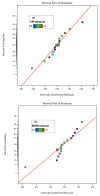Evaluating the Biodegradation of Veterinary Antibiotics Using Kinetics Model and Response Surface Methodology
- PMID: 36080173
- PMCID: PMC9457998
- DOI: 10.3390/molecules27175402
Evaluating the Biodegradation of Veterinary Antibiotics Using Kinetics Model and Response Surface Methodology
Abstract
The inappropriate use and indiscriminate disposal of antibiotics has become a menace worldwide. The incomplete removal of these contaminants from wastewater treatment plants has also contributed to this. This study presents the biodegradation of two veterinary antibiotics; ciprofloxacin (CIP) and enrofloxacin (ENRO). Kinetics models were explored to understand the dynamics of biodegradation in an anaerobic digestion process. This was carried out in batch reactors under various operating conditions: pH, organic loading rate (OLR), and antibiotic concentration. The influence of the parameters was investigated using a response surface methodology (RSM) based on the Box-Behnken experimental design of 15 runs. The data obtained were fitted on a polynomial function model. OLR and pH exhibited a synergistic and antagonistic effect in the response models developed, with a high correlation regression coefficient (R2; 0.9834-0.9875) close to 1 at a 95% confidence level. The optimum conditions obtained from the RSM numerical optimization were pH (6), OLR (2 kgCOD·m-3·days-1), and an antibiotic concentration of 75%, which gave the removal of CIP, ENRO, and COD, respectively, as 80%, 83%, and 73% at a desirability function of 85%. The kinetics study shows that the biodegradation of antibiotics was well fitted on a first-order model (R2; 0.9885-0.9978) with rate constants ranging from 0.0695 to 0.96 days-1.
Keywords: anaerobic digestion; antibiotics; biodegradation; ciprofloxacin; enrofloxacin; kinetics; response surface methodology; wastewater.
Conflict of interest statement
The authors declare no conflict of interest.
Figures











References
-
- Alqarni N., Fawzy A., El-Gammal B., Toghan A., Hassan N.A., Algarni Z. Auspicious water treatment approach. Oxidative degradation of fluconazole and voriconazole antibiotics by CrO3 in different acidic environments: Kinetics, mechanistic and thermodynamic modelling. J. Saudi Chem. Soc. 2022;26:101396. doi: 10.1016/j.jscs.2021.101396. - DOI
-
- Morley G.L., Wacogne I.D. UK recommendations for combating antimicrobial resistance: A review of ‘antimicrobial stewardship: Systems and processes for effective antimicrobial medicine use’ (NICE guideline NG15, 2015) and related guidance. Arch. Dis. Child. Educ. Pract. 2018;103:46–49. doi: 10.1136/archdischild-2016-311557. - DOI - PubMed
-
- Liu C., Li B., Liu M., Mao S. Demand, status, and prospect of antibiotics detection in the environment. Sens. Actuators B Chem. 2022;369:132383. doi: 10.1016/j.snb.2022.132383. - DOI
-
- Haffiez N., Chung T.H., Zakaria B.S., Shahidi M., Mezbahuddin S., Hai F.I., Dhar B.R. A critical review of process parameters influencing the fate of antibiotic resistance genes in the anaerobic digestion of organic waste. Bioresour. Technol. 2022;354:127189. doi: 10.1016/j.biortech.2022.127189. - DOI - PubMed
MeSH terms
Substances
LinkOut - more resources
Full Text Sources
Medical

